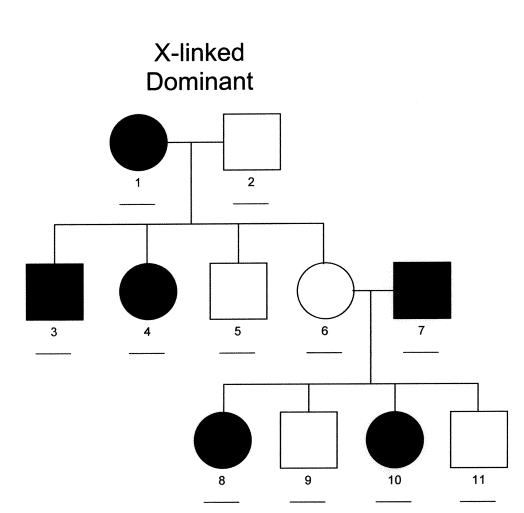
Sex (X)-linked Dominant Inheritance Blank Pedigree (PDF)
Sex (X)-linked Dominant Inheritance Pedigree Example Answers (PDF)
When completing this pedigree with X-linked dominant inheritance, use the symbols X and Y in the genotype to represent the sex chromosomes passed on from the previous generation. The X chromosome will contain the alleles for the trait and the Y chromosome will have no alleles for this trait. When completing this pedigree with X-linked dominant inheritance, non-shaded females who are expressing the recessive phenotype and can only have the genotype of XrXr, the non-shaded males who are expressing the recessive phenotype and can only have the genotype of XrY, and the shaded males who are expressing the dominant phenotype and can only have the genotype XRY. Use this knowledge and additional knowledge about how genes are passed from generation to generation to complete the remainder of the pedigree.
Patterns for X-linked Dominant Inheritance
After filling in the genotypes for individuals in several family trees that exhibit this mode of inheritance, some patterns that can be noticed are:
- All daughters of a male who has the trait will also have the trait.
- There is no male to male transmission; the trait follows the inheritance of the X-chromosome.
- Sons can have the trait only if their mother also has the trait.
- Same inheritance pattern as autosomal dominant traits in human females.
Remember:
- The father passes his X sex chromosome (and all its genes) to his daughters and his Y sex chromosome (with its genes) to his sons.
- Genes act in pairs, one from each parent for the females. For this mode of inheritance, males get their gene for the trait from their mother.
- Gene pairs separate during meiosis and the formation of the sex cells along with the chromosomes.
- When the sperm fertilizes the egg, the father’s genes (and chromosomes) join the mother’s, or both contribute to the genetic makeup of the offspring.
- One form of a gene may be dominant over another form which is recessive and the dominant form would be expressed.
X-inactivation
X-inactivation, also known as lyonization after Mary Lyon who discovered the phenomenon, is a process by which one of the copies of the X chromosome present in female mammals is inactivated very early in embryonic development. In XX females, the majority of the genes on the X chromosome are silenced. This stops females from having twice as much gene product compared to males. The choice of which X chromosome is inactivated is random and should occur at approximately a 50/50 ratio. If this inactivation does not occur at a 50/50 ratio it is called skewed X-inactivation, or skewed lyonization. Skewed X-inactivation causes more gene product from one X to be expressed, which can disrupt the typical “X-linked dominant” model. If more of the gene product from the unaffected gene is expressed in a female, the “X-linked dominant” condition may not be expressed in a female or may have a range of signs and symptoms. A woman with skewed X-inactivation will still pass down the gene variant to half of her children.
Other things to keep in mind:
- A female with Turner syndrome will only have one X and will therefore express “X-linked dominant” condition with no influence of X-inactivation
- A female with an ‘XXX’ genotype may have a different X-inactivation pattern with varying symptoms
- A male with an ‘XXY’ genotype may have skewed X-inactivation as well
- Examples of X linked dominant conditions: X-linked hypophosphatemia, Fragile X syndrome
X-linked dominant with male lethality
Some X-linked dominant conditions are lethal in a hemizygous individual such as a male (‘XY’) or a female with Turner syndrome (‘XO’ or ‘X-‘). Conditions such as Rett syndrome, incontinentia pigmenti (IP), oral-facial-digital I (OFD I) syndrome, focal dermal hypoplasia, and X-linked Chondrodysplasia Puncatata Type 2 usually result in early gestational male lethality. One exception to this is an ‘XXY’ genotype, which may result in an affected male.
